Light A Fire 2013

To find our Light A Fire honorees, Portland Monthly uses a four-step process:
1. We gather: We ask everyone we know, including our readers, and find experts with a wide vision of the city.
2. We review: With a panel of the region’s top foundation and corporate-giving leaders, we score every nomination.
3. We debate: Using the top-scoring nominations as a starting point, panel members weigh the information submitted, their own knowledge of the individuals and organizations, and their convergences and differences of opinion.
4. We select: There’s always more good work than can be awarded—but there’s always next year.

Lifetime Achievement | Mary Vinton Folberg
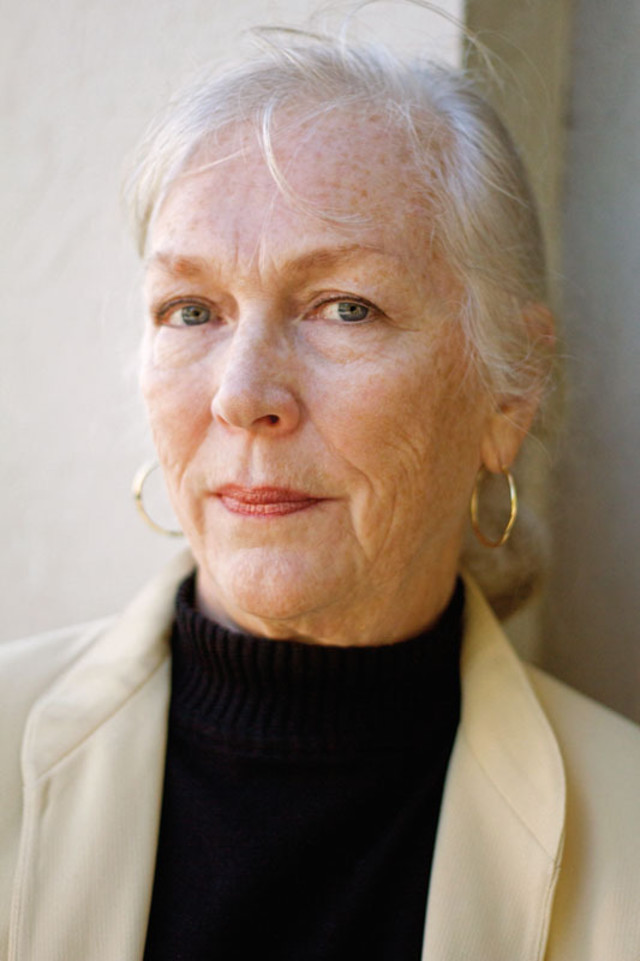
Image: Ashley Anderson
“MY FAMILY says that I am the Great White,” says Mary Vinton Folberg, 73, waving her hand like a shark gliding through water, nearly upsetting one of the many piles of papers crowding the desk of her cluttered office at Portland’s Northwest Academy. “I have to keep moving...I have that energy because I feel so strongly about what I do.”
When Folberg moves, the city of Portland is often changed in her wake—for good. Over four decades the McMinnville native has enthusiastically championed the marriage of arts and education, building theaters and cultivating future dancers, writers, and scientists as she goes.
After teaching English and dance in California high schools in the late 1960s, the lifelong performer returned to Oregon to find Portland schools didn’t even have a dance program. She pushed administrators and lawmakers, and, in 1969, she launched the Jefferson High School dance department and then, in 1976, the lauded Jefferson Dancers performance group, whose alums now pepper professional dance companies across the nation. In the early ’80s, as the chair of the mayor-appointed Arts Needs and Use Committee, she helped propose the Newmark and Winningstad Theatres, despite the public’s skepticism that there would be the audience to fill them.
IMPACT INDEX
38
Years Jefferson Dancers have been performing
186
Students who have graduated from Northwest Academy since 1997
448,500
Dollars Northwest Academy awarded for student financial aid in the 2013–14 year
1
Brother famous for Claymation film and TV work
By 1997, the tenacious educator was on the move again. Wanting to develop an art program that was just as rigorous as it was academic, she founded Northwest Academy, her own independent, arts-focused middle and high school housed in an ad hoc quartet of buildings downtown. The private school integrates a very tough academic course load with wildly creative art projects—a place where science students construct comic books about chemical bonding, sixth graders read Kafka, and tap class is mandatory. (It teaches focus and concentration, she says.) Colleges court its savvy grads, and a surprising number of alums end up in the sciences.
“Mary’s impact is immense,” says McKenzie Kerman, an animator based in Los Angeles who graduated in 2006 from NWA. When a lack of funds barred the then-14-year-old Kerman from attending the school in 2002, Folberg wrangled a four-year, full-ride scholarship for the dyslexic cartoon buff from civic patron Arlene Schnitzer. Some 25 to 30 percent of the academy’s 182 students receive a variety of financial aid.
“She lives and breathes this school,” says John Thomas, the chairman of NWA’s board of trustees. “She has no ego—it’s all about the kids.”
Next up, Folberg is moving toward a permanent building for the school, which would also house affordable after-school arts classes for any kid who wants them. “It’s just so important to give young people an education that helps them adapt, to enjoy all kinds of people, literature, and art,” she says, practically dancing out of her seat. “That gives them the confidence to follow their dreams.”

Cultivating Creativity | Oregon Children’s Theatre
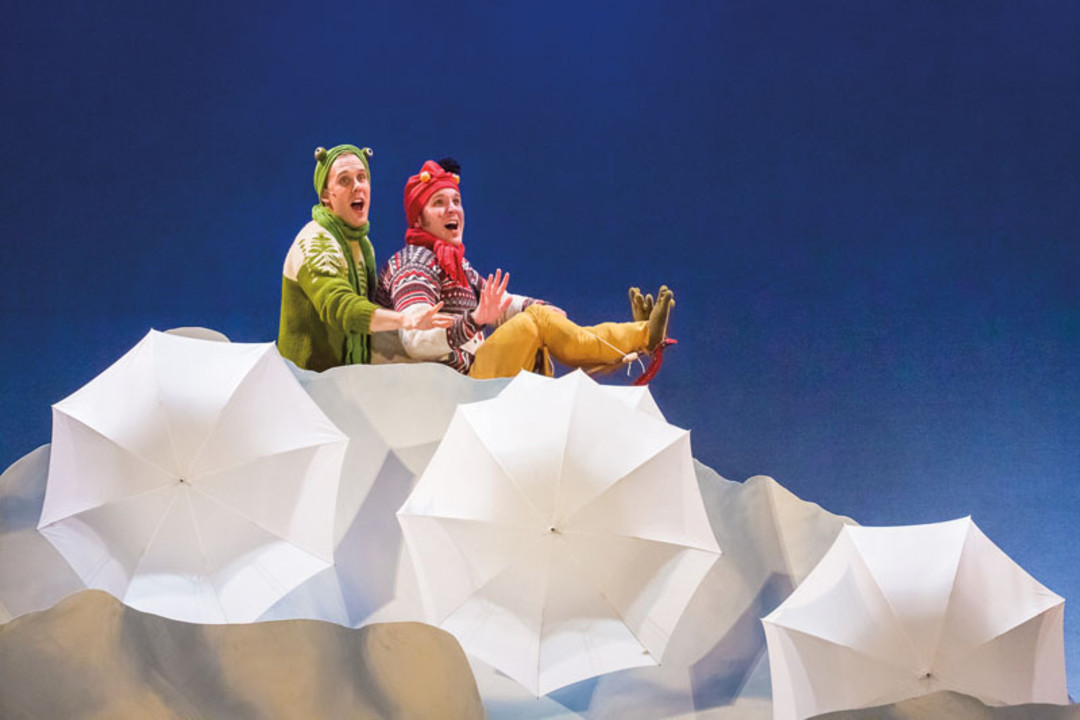
If you were seeking a poster child for Oregon Children’s Theatre, few could fit the showbill like Madeleine Rogers. She got involved in the 25-year-old theater company at age 6, playing Zuzu in It’s a Wonderful Life. She took acting classes at OCT’s school throughout her childhood. Today, the 19-year-old is studying theater at Juilliard, with dreams of a career in acting. And she gives the credit to OCT.
IMPACT INDEX
80,000
Students and teachers who saw OCT shows last season
7
Drammy Awards this year’s production of A Year with Frog and Toad received
2
Factor by which OCT’s move increased its classroom space
“When I took my first acting class with Stan,” she says of OCT Artistic Director Stan Foote, “what had once been just a show on a stage was transformed into a world of imagination, connection, expression, and endless possibility.”
Foote started out at OCT as a production gofer 23 years ago. He swells with pride when he talks about Rogers. But in the same breath, he says the big stage is not the ultimate goal. Instead, acting skills are merely a byproduct of what OCT really creates: “out-loud kids.” “The training is really about raising good human beings with voices in their communities,” he says.
OCT’s drama classes annually prepare 1,200 students, ages 3 to 18, for a vocal life, and the company’s well-regarded productions, such as last season’s A Year with Frog and Toad, expose thousands of kids to the art of theater. But the nonprofit is still working to expand its reach. Last year, it moved from downtown to the more residential, school-filled Kerns neighborhood to improve its accessibility. “Theater helped create the person I am—it was a place where I could be me,” Foote says. “I want that place for every kid who wants it.”

EXTRAORDINARY YOUNG CITIZEN | ALEX HORSEY
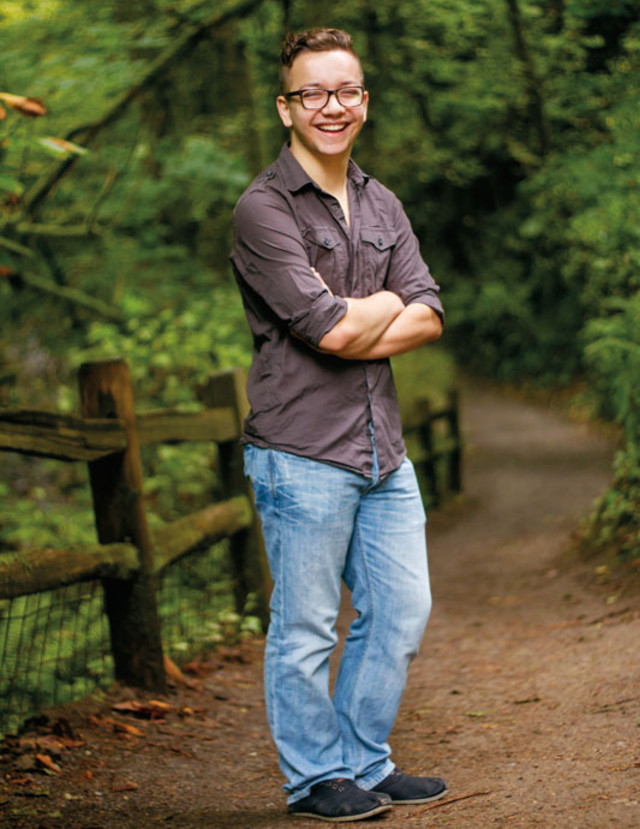
Image: Ashley Anderson
The young, an old adage claims, are the leaders of tomorrow. Alex Horsey, for one, isn’t waiting.
The 2013 Wilson High graduate has held board and leadership positions with groups ranging from Friends of Outdoor School to the Oregon Lutheran Youth Organization. As a high-school junior, he founded Project Believe in Me, an initiative that fights bullying and bullying-related suicide by, among other things, publishing open letters from former victims on its website.
Horsey came out of the closet at age 12 and is no stranger to the prejudice of children and the consequent feelings of isolation and hopelessness. But it was the media storm around a string of suicides several years ago that incited him to step up. “What scared me was that the only things that were in the media were people committing suicide due to bullying,” Horsey, now 18, says. “I was worried that would create this false assumption that that’s the only way out.”
IMPACT INDEX
7
Boards on which Horsey has served
16
Age Horsey founded Project Believe in Me
560
Project Believe in Me’s average monthly visitors
So Horsey created a website, printed fliers, and reached out to community groups and national partners. The letters he received from other bullied youth offer glimpses beyond the darkness. “Some days are going to be horrible, but ... there are people, near and far, who are waiting to love you,” one promises. “I was you. I am you,” says another.
As he moves on to Portland State University to study community development, Horsey is working to keep high school students involved in Project Believe in Me leadership. “There’s so much change we can create right now,” he says.

BEST NEW NONPROFIT | App Camp for Girls
The future of computer science may be wearing a pair of dangly motherboard earrings and talking a mile a minute about what it takes to build your own app. “We spent a lot of time on it, and I pulled out a lot of hairs over it,” 15-year-old Aysa Klocke says, ear-ware flapping as she shows off an iPod Touch loaded with a quiz app that she helped brainstorm, program, design, and debug during Portland’s first-ever App Camp for Girls this past summer. “But the harder you work, the more gratifying it is.”
That’s music to Jean MacDonald’s ears. Disturbed by the lack of women in her industry, the partner at local Mac and iPhone development firm Smile decided to mash up summer camp fun with tech lessons to get middle school girls hooked on app-making. Her idea struck a nerve. App Camp reached its original $50,000 fundraising goal on IndieGoGo in three days. The all-volunteer nonprofit has since raised more than $106,000 and kicked off its first camp in June.
IMPACT INDEX
9
Percentage of IT management positions held by women
9
Months AC4G has existed [established February 2013]
3
Days it took AC4G to meet its initial $50,000 fundraising goal
24
Girls AC4G taught programming skills to in summer 2013
Camp was set up at the SE Belmont café TaborSpace, where the girls slurped Italian sodas as they scribbled out their ideas and learned the nuts and bolts of app development from an all-lady cadre of tech pros. At the end of the five-day camp, the girls presented their creations to a panel of local women investors and entrepreneurs and scored a copy of the Big Nerd Ranch programming book.
With two camps under their belt this summer alone, MacDonald and AC4G’s lone developer, Natalie Osten, have already been inundated with pleas for camps in cities from Denver to New York. The goal for 2014 is three PDX camp sessions and to launch a new camp in at least one other city—they just need more “nerdy women” to volunteer their time. But for now, they’re still high-fiving campers over what they did last summer.
“I got to design a program and then do yoga and hula-hoop—it was legit,” says Klocke. “The technology and engineering fields really are limited for women. App Camp gives you that confidence to believe that, yeah, I can do this.”
Video photos courtesy Justin Miller/Mallorn Images and Curtis Settino/Canoofle.

EMERGING LEADER | Pamela Butler
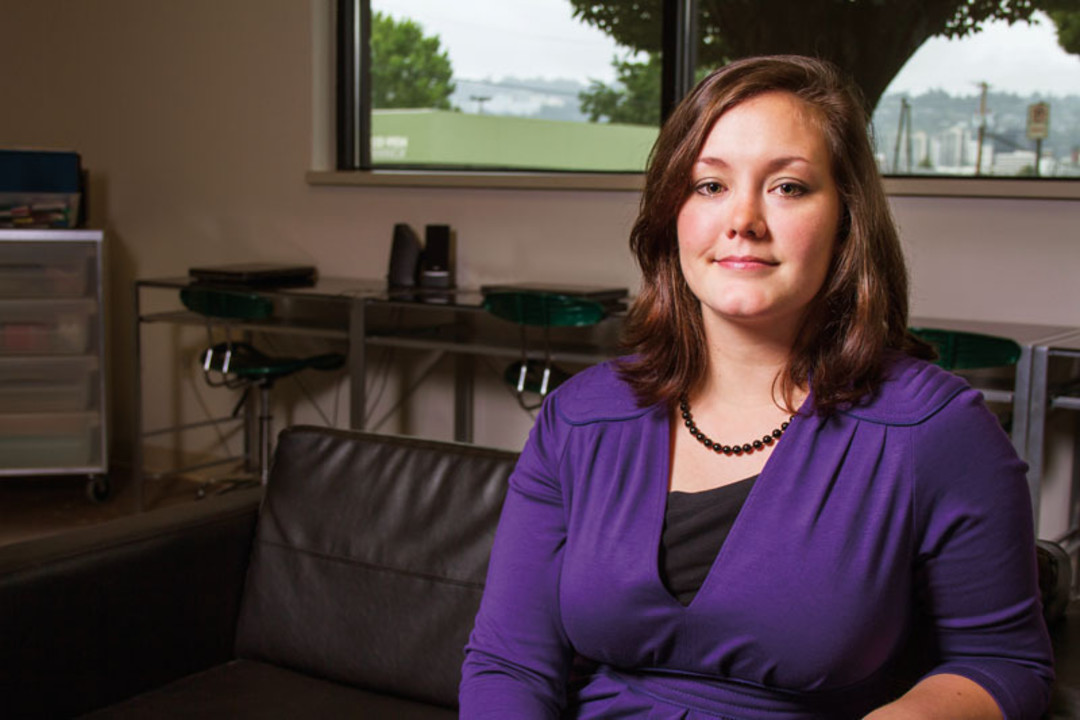
Image: Ashley Anderson
For much of her youth, Pamela Butler had little control over her world. Her mentally ill mother and stepfather carted her around the country until the Oregon Department of Human Services removed her from their custody and put her into Oregon’s foster-care system at age 7. Over the next 11 years, she lived in eight different homes, enduring not only abuse but the feeling, endemic to the system, of utter powerlessness.
“You’re just kind of floating,” she says, “like you’re no one’s child.”
IMPACT INDEX
5
Years Oregon Foster Youth Connection has existed
100+
Foster youth who have participated in the program
88/88
Proportion of voting Oregon legislators who approved OFYC’s 2013 priority legislation
The anxiety Butler felt growing up helps explain the potency the 29-year-old brings to her work today. As the director of Oregon Foster Youth Connection, a program of the child-advocacy nonprofit Children First for Oregon, Butler leads foster youth in lobbying for child-welfare reforms at the state legislature. Since founding the program in 2008, Butler and her crusaders-in-training have scored a perfect record: four out of four bills. These have not been small asks: in 2011, for instance, OFYC pushed through legislation allowing foster-care alumni to attend state colleges for free.
“Getting legislation passed in Salem is an arduous process,” says Chip Shields, a state senator who sponsored an OFYC-backed bill this year to create a foster youth “bill of rights.” “Pamela brought together Oregon’s most vulnerable population and empowered them with the tools they need to advocate for themselves.”
Butler is also pushing child-welfare reform beyond Salem, collaborating with Oregon’s senators on federal issues and working on national committees. The erstwhile ward of the state hasn’t, however, forgotten where she came from—and wouldn’t want to.
“If I’m in a room with a bunch of administrators, no one can say, ‘No, that’s not how things happen,’” she says. “I’ve been there: I’ve got my stories; I’ve got the youth’s stories; I’ve got the research. It’s a powerful combination.”

HONORING OUR ELDERS | SAGE METRO

Image: Ashley Anderson
When it comes to finding long-term care as a senior with failing health, lesbian, gay, bisexual, and transgender people are only half as likely as their straight peers to have a relative support them. But it’s no easier to turn to assisted-living facilities. In a 2011 survey, 43 percent of LGBT residents, relatives, and staff reported mistreatment in such places, including harassment and being refused admission or discharged abruptly.
“Getting old is hard enough,” says Vaune Albanese, executive director of the social service agency Friendly House and herself an out-and-proud 56-year-old. “If you’re also a member of a cutting-edge minority group, it’s a double whammy.”
IMPACT INDEX
10,000
Estimated number of LGBT seniors in Portland
2
Factor by which the number of lesbians, gays, and bisexuals 65 and older in the US is expected to increase between 1999 and 2030
858
People SAGE Metro Portland trained in 2012
Friendly House’s SAGE Metro Portland program aims to soften the blow. The 12-year-old program (called Gay & Grey until it affiliated in 2011 with the national organization Services and Advocacy for GLBT Elders) trains eldercare providers in LGBT-specific issues, advocates for fair housing, and hosts social events so sexual-minority seniors can get together for support.
“We hear stories of people who have been activists their whole life, then have to go back in the closet when they move into an assisted-living facility,” says Lauren Fontanarosa, SAGE Metro Portland’s coordinator. “They’re afraid of the service providers; they’re afraid of their straight peers.”
While Fontanarosa oversees a crack team of volunteers working to obviate that fear, she says the country’s estimated 1.75 to 4 million LGBT seniors need—and deserve—more attention, especially from the gay community. Younger gays are “benefiting from the road elders have paved,” she points out. “The least we can do is bind ourselves together as a community to support them as they’re facing these challenges we will all face.”

Inspiring Our Next Generation | Playworks

Image: Courtesy Playworks
Portland Playworks lives and breathes recess. Inside its headquarters on SE Madison Street, shelves overflow with bright orange cones, multicolored dodgeballs, and plastic goalposts. Impromptu foursquare games are a daily occurrence for the staff, but they’re merely practice for the four-year-old nonprofit’s real goal: teaching thousands of kids the social tools they need to play safe and healthy in the 14 metro schools it works with daily (in addition to 80-plus regional schools it services indirectly).
“Group play isn’t what it used to be,” says Jonathan Blasher, executive director of Playworks’ Pacific Northwest branch. Instead of being that carefree respite for games and sports that most adults remember nostalgically, he says, recess is now a time when almost 90 percent of negative issues in schools erupt, from schoolyard bullying to gender exclusion.
IMPACT INDEX
6,000
Students directly served in Portland
85 & 90
Percentages of Portland teachers who report a decrease in bullying and an increase in academic participation, respectively
To confront that change, a think tank of teachers, summer camp directors, and sports instructors created Playworks in Oakland, California, in 1996; Portland’s division started in 2009. The goal: to create positive, respectful, and inclusive play environments for often-stressful low-income communities. And Playworks’ 20 staff members do it by taking all that equipment off the shelves and into schoolyards.
“We don’t do win or lose, boys versus girls, or team captains,” Blasher explains. “There is a common language that everyone understands, and we solve conflicts with simple games like rock-paper-scissors.” To this end, one of Playworks’ most effective projects, the Junior Coach Program, pairs older elementary students with younger students to learn games and solve their own conflicts as they arise, giving the older kids responsibility and the younger ones role models.
“Playworks has been about creating a kind and cooperative atmosphere around the school,” says Susan McElroy, principal of Daniel A. Grout Elementary, which has spent four years in the program. “All my kids follow the same rules, procedures, and conflict resolution processes, which translates to less fighting at recess and more instructional time in the classroom.”
{page break}Extraordinary BOARD MEMBER | Julie Ball, I Have a Dream Oregon
For six years, Julie Ball was a solid board member, raising money for and tutoring kids from low-income families through Oregon’s I Have a Dream (IHAD), a program devoted to helping them get through school and into college. But in 2003, the retired teacher decided to take a leap in scale: she “adopted” an entire third-grade class at Woodlawn Elementary. She committed to help guide all 52 students through their K–12 school careers, as well as to raise more than $800,000 in start-up funds with to hire IHAD staff to manage the kids’ day-to-day progress.
IMPACT INDEX
18
Number of years Ball has volunteered for I Have a Dream
1500
Number of kids Oregon’s I Have a Dream has “adopted” since 1990
70–80
Percentage of “Dreamers” who graduate high school
30–40
Percentage of kids in IHAD’s target demographic usually expected to graduate
A decade later, after meeting with her students for regular after-school tutoring and carting kids on trips to museums and college visits, Ball’s original “Dreamers” finally achieved their goal. “I made these for all of them,” the 70-year-old says proudly as she holds up a silver key inscribed with the words: “Dreamer 2013: The key is in your hand.” “I’m amazed by their resiliency and strength.”
Her “kids,” many of whom come from troubled, low-income homes, agree. “I owe her a lot—she’s helped my education over my whole life,” says 18-year-old Jasmine Oddie, who just started classes at Portland Community College, funded through scholarships the IHAD team helped her secure. She remembers being “blown away” by an Art Camp at Willamette University that Ball encouraged her to attend in 2011. Oddie now plans to major in graphic design and art history.
“Julie is a force to be reckoned with,” says IHAD’s annual giving manager, Kari Morin. “And she does this in the kindest, quietest, and most graceful way possible.”

Game-Changing Project | Doernbecher Freestyle, Nike/OHSU Doernbecher Children’s Hospital
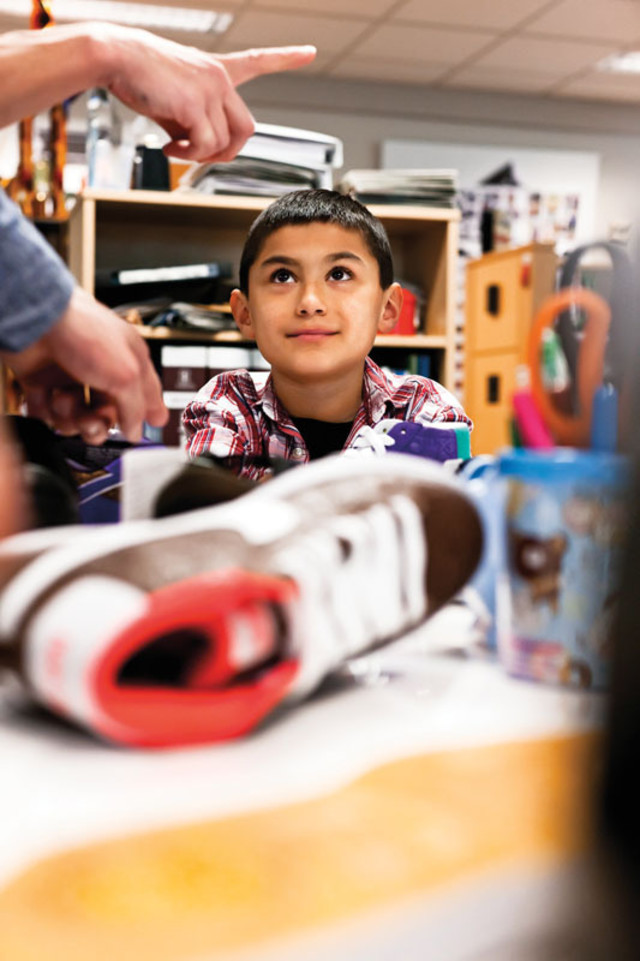
Image: Courtesy Dan Root
Cole Johanson was 9 years old when they found it: a tumor in his abdomen the size of a grapefruit—and growing fast. Diagnosed with an aggressive lymphoma, the boy spent over three months undergoing intensive chemotherapy at OHSU Doernbecher Children’s Hospital, finally beating the cancer in 2010. The universe doesn’t typically give out prizes, but what happened to Johanson next felt like a cosmic recompense: thanks to the Doernbecher Freestyle program, a partnership between the hospital and Nike, he got to design his own Nike shoes.
“It’s like you’re being rewarded for surviving cancer,” the now 14-year-old remembers.
Started in 2003, each year this one-of-a-kind project takes six to seven Doernbecher patients (some who’ve won their battle against their illness, some still fighting), pairs them with Nike designers, and lets them create totally customized shoes. These limited-edition styles are then sold at Nike stores and online, as well as at an annual auction, to raise money for Doernbecher. In its first year, the program brought in $120,000 for the hospital; it raised about $1.5 million in 2012.
IMPACT INDEX
58
Patients who have participated in Doernbecher Freestyle
$14,000
Average amount shoes are auctioned for
$6+ million
Total amount raised over 10 years
“It’s taken on a life of its own,” says Michael Doherty, Nike’s global creative director for brand presentations, who after joining Doernbecher’s board started the project based on an idea from his then-teenage sneaker-head son.
For the hospital, Doernbecher Freestyle is a funding source for trailblazing research, equipment, and patient financial aid. For the participants, it’s an invaluable opportunity to express their harrowing experience through design. If you look inside Johanson’s red Air Jordans, for example, you’ll find two words—“the two main things that helped me get through cancer,” he says—emblazoned on the insoles: “strength” and “courage.”
“Every story is unique to the child that’s creating this footwear,” says Doherty. “I’m amazed at the things these kids have gone through, and how that’s reflected in their shoes.”

Keeping Us Healthy | Oregon Food Bank

Image: Courtesy Oregon Food Bank
Behind Oregon Food Bank’s cavernous loading docks in Northeast Portland, where more than three million pounds of food are distributed every month, sits a garden brimming with jalapeño plants, lacy stalks of quinoa, and several chickens. This is the food bank’s Learning Garden, where low-income communities learn how to grow their own food and, in the process, help provide 17,000 pounds of fresh vegetables annually to hungry households around the state.
IMPACT INDEX
43.1 million
Pounds of food distributed in 2012
270,000
Oregonians served each month
20–30
Percentage of food from Oregon farms
The garden is just one of the $56.9 million nonprofit’s new initiatives putting it at the national forefront of food banks, by focusing, not just on providing food, but on nutrition and preventive measures against hunger.
“There is a shift in the food-banking world from thinking about hunger as just a social justice issue to thinking about it as a public health issue,” says CEO Susannah Morgan, who has led the 31-year-old nonprofit since 2012. To help address what Morgan calls “hunger with a big H,” the Oregon Food Bank has pioneered programs at every level. Cooking Matters courses teach low-income Oregonians the basics of cooking at home with an eye on nutrition and practical budgeting. The FEAST program (Food, Education, Agriculture Solutions Together) digs deep into local food systems—from farmers to grocery owners to school principals—and brings together the community to establish healthy symbiotic relationships where none exist. Finally, CHOP (Choose Healthy Options Program) ranks the nutritional value of OFB’s inventory, ensuring that hungry families are eating their proverbial broccoli. “Clients are dying for fresh produce,” Morgan says. “You still need to sell a rutabaga over a bag of potato chips, but putting a real focus on nutrition isn’t rocket science.”

Extraordinary VOLUNTEER | Michael BeRgmann
For his day job with Nike, Michael Bergmann builds sneakers out of the most advanced and sustainable materials to be found. On his off hours, he builds sports access in the most challenging of circumstances.
IMPACT INDEX
$500,000
Estimated cost of Roosevelt’s track
54
Years since a relay team had placed at state championships—until 2013.
A few years ago, Roosevelt High School’s athletic facilities were in shambles. “The football field looked like a mud pit, the track resembled a parking lot, and the old wooden bleachers were rotted and condemned,” says Principal Charlene Williams.
Bergmann had already founded the PDXC youth cross-country program and invigorated track and field at Central Catholic and Holy Trinity schools. But North Portland’s Roosevelt, where 75 percent of students are from low-income families, presented much higher stakes.
“The vision was to build not just a regionally recognized athletic facility, but also a community center for St. Johns, where poor, high-immigrant populations were stuck in a school district that had given up,” says the 52-year-old. Beginning in 2007, he gathered diverse partners, from his church to Nike, to rebuild the school’s athletics field, including the crown jewel: a 400-meter track.
The result? School enrollment has increased since the project’s inception and Roosevelt athletes have catapulted into state championships. “It stands as a shining star in the St. Johns community and the envy of the entire city,” says Principal Williams.

Extraordinary Executive Director | Barb Attridge, Dress for Success
Barb Attridge’spinstriped slacks subtly match her blue-and-white-striped cardigan. The yellow of her tiered necklace echoes the gold of her dangly earrings.
She is, in a phrase, put together—and that hardly comes as a surprise. As the executive director of Dress for Success Oregon, a nonprofit that provides professional attire and other career support to low-income women, Attridge knows as well as anyone the value of the right outfit.
“I see women come in in sweats and a sweatshirt, and their head is sort of hanging,” the 64-year-old says. “An hour later, I see them standing in front of a three-way mirror in a suit, and I swear they’re standing 10 feet tall.”
IMPACT INDEX
16,000+
Women DFS has served
2
Years Attridge volunteered before being paid
900 vs. 6,000
Area, in square feet, of Dress for Success’s original location vs. its current location
Fourteen years ago, the then-CPA cofounded the Oregon chapter of Dress for Success in a cramped Northwest Portland space with a fundraising-savvy friend. In year one, the organization outfitted nearly 400 women. By 2009, they served 2,500, and the 12-employee nonprofit was helping hundreds of its clients land jobs. The Oregon satellite serves about three times as many new women as the average chapter.
Of course, dressing well alone doesn’t assure success. That’s why, under Attridge’s leadership, the local chapter has expanded its programs to include a networking group, career-development workshops, a job retention program, and a mentor service.
Attridge is equally astute at navigating the fundraising world. Last year, the organization netted more than $200,000 at its annual gala and scored a $200,000 grant from Bank of America, expanding its annual budget to $666,000. Attridge is “incredibly persuasive,” says the nonprofit’s board president, JoDee Keegan, but she’s more than a pitchwoman. She sees how the parts of the organization go together. “An executive director who understands the organization as a whole as well as she does is unbelievably rare,” Keegan says. “Barb is a complete package.”

Most with the Least | The Children’s Book Bank
For the kids at Earl Boyles Elementary, having Dr. Seuss around the house isn’t a given. Nearly a quarter of the outer Southeast school’s families have 10 or fewer books at home and little access to libraries. That’s where the Children’s Book Bank comes in: handing out bags filled with a lovingly curated mix of alphabet, poetry, and picture books to low-income families to give youngsters a boost in the literacy department.
Before becoming the nonprofit book fairy, CBB founder Danielle Swope, 49, taught math in rural North Carolina with Teach for America. “I saw how bleak the future was if you’re in high school and really can’t read,” she recalls. “We have to get books in the hands of kids as soon as we can.”
IMPACT INDEX
140,000
Annual budget for the three-staff-member organization
8,521
Kids who received books through CBB in 2012–2013
16
Books a child receives in every CBB bag
Since 2007, the organization has made sure all Head Start preschoolers in Multnomah County have books to call their own, in addition to stocking book fairs and providing “book prescriptions” for Children’s Community Clinic patients—all with three staffers and an annual budget of $140,000.
“This model works because it’s easy for anybody to get involved,” says Swope. Every week, new volunteers and longtime helpers crowd into the nonprofit’s cramped, cheery Northeast Portland headquarters to sort through the overflowing donation boxes. They gab like a coffee klatch as they scrub covers with lemony cleaner and tape up torn pages, gasping in delight when they rediscover old favorites.
“Their work means my children have access to books,” says Earl Boyles Principal Ericka Guynes. “When you see these little guys walking out the door with those green book bags, they just treasure them. It is like we are giving them gold.”

CARING FOR THE PLANET | Backyard Habitat Certification Program

Under a darkNorthwest canopy, verdant sword ferns and wild oxalis sprout in the underbrush while fearless baby Douglas squirrels scurry down their towering namesake trees. This isn’t a stretch of Forest Park or Oaks Bottom Wildlife Refuge, though. It’s the lawn of West Hills homeowner Lorena O’Neill, and it has earned her the highest honor in the Backyard Habitat Certification Program: platinum.
In a partnership, the Columbia Land Trust and Audubon Society of Portland first piloted the program in 2006 with a handful of homeowners pledging to eradicate the worst invasive plants from their yards (top of the hit list: ivy and blackberry) and to garden solely with Willamette Valley natives. Flash-forward to 2013: more than 1,750 properties are enrolled across Portland, with at least 50,000 native plants distributed at wholesale prices from local nurseries. Backyards are surveyed by expert technicians, reassessed by an army of trained volunteers, and given a certification level from silver to platinum, with a prominent sign in the front yard championing the achievement.
IMPACT INDEX
$25
Cost of a site visit
679
Households certified silver or higher
800
Volunteer hours devoted to backyard assessment in 2012
“The program essentially relies on community-based social marketing,” says program manager Gaylen Beatty, “and it’s incredibly effective.” The backyard certification community has grown so rapidly, that the total acreage now amounts to around 330. In comparison, Hoyt Arboretum has 187 acres. Eventually, Beatty hopes, the program will form entirely native corridors throughout the city.
But habitat certification is about more than one-upping your neighbors or putting a fence around a wild piece of land. “You experience wildlife and preservation at a very personal level in your own backyard,” says O’Neill as she gives a tour, proffering the tart, bright fruits from a thimbleberry shrub.

Extraordinary Pro Bono | FRED MEYER, Store to Door and the American Cancer Society
Fred Meyer donates $4 million and more than four million pounds of food annually. But for 85-year-old Portlander Jean Brooks, the homegrown grocery chain’s commitment to its community begins and ends with the fact that she can buy her favorite sugar snap cookies without hobbling to the store. “I have leg problems, and it’s hard to get out,” Brooks says, “so I really depend on them.”
For nearly a quarter century, the West Burnside Fred Meyer has been the unofficial headquarters of Portland nonprofit Store to Door. Every week, a wave of volunteers rolls through the grocery gathering blue bins of food to deliver to people with disabilities and vulnerable seniors like Brooks. The retailer reserves checkers and baggers for the operation, and donates around $30,000 yearly.
IMPACT INDEX
24
Years Fred Meyer has partenered with Store to Door
400
Portlanders to whom the program delivered groceries last year
2.3
million Dollars raised by Fred Meyer volunteers for the American Cancer Society since 1985
Store to Door is just one of the partnerships to which the company’s 33,000-person workforce dedicates tens of thousands of unpaid hours every year. The projects range from small, like cleaning up local parks, to one of the company’s biggest: the donation of $2.3 million since 1985 to the American Cancer Society. Nearly half of that sum has been raised from small-scale Relay for Life walks instigated by 250 separate teams of employees across Oregon, Washington, Idaho, and Alaska.
“We can’t tell them what to volunteer for: it’s whatever makes an employee passionate,” says Fred Meyer Manager of Community Affairs Melinda Merrill. But her office can give encouragement in the form of $200 in seed money to every employee group that mounts a volunteer effort.
Forbes magazine dubbed Fred Meyer’s parent corporation, Kroger, America’s “most generous” company in 2011. But Merrill says that the nearly century-old retailer’s mind-set came from the original Fred G. Meyer, a crack businessman who was also known for donating time and money to local nonprofits. “This company grew up in Portland and shares its values,” she says. “You don’t [volunteer] to make yourself look good. You do it to keep employees, to keep customers, and to keep your community strong.”
